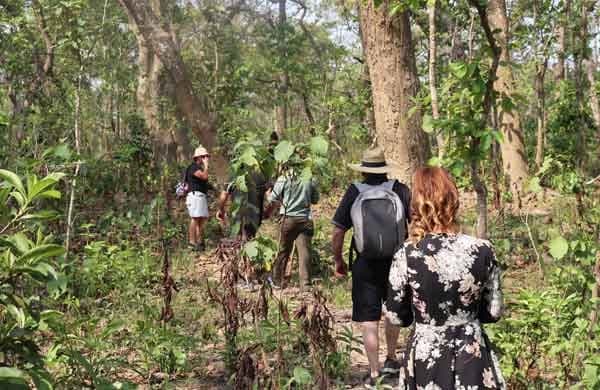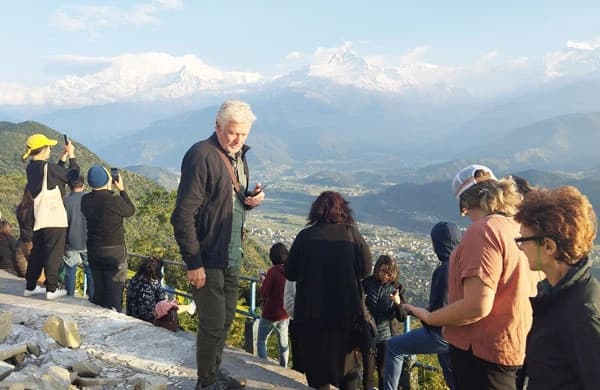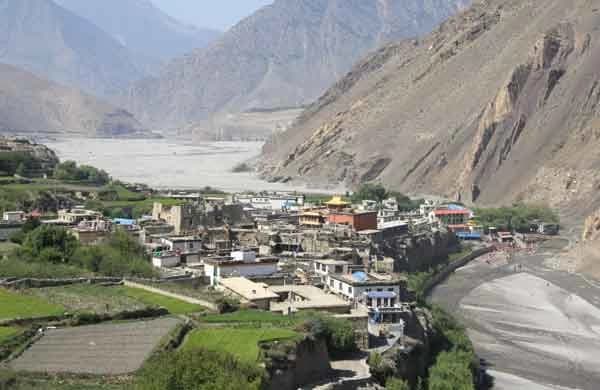Best Time to Visit Upper Mustang
The best time to visit Upper Mustang is during the spring (March to May) and Autumn (September to November). The weather is clear, and the mountain views are stunning in these seasons. The roads are dry enough for smooth Jeep travel.
Spring (March to May) – The Season of Color and Festivals
Spring is one of the most popular times for the Upper Mustang Jeep Tour. The days are pleasantly warm, with temperatures ranging between 16°C and 22°C, and the skies are bright and blue in the Spring Season. The arid cliffs and canyons glow in the sunlight, making them perfect for photography and sightseeing.
If you travel in May, you’ll witness the spectacular Tiji Festival in Lo Manthang, a three-day celebration of Tibetan Buddhist culture featuring masked dances, chanting monks, and centuries-old rituals.
Autumn (September to November) – The Season of Clarity
After the monsoon, the air becomes crisp and the scenery incredibly sharp. The skies remain crystal clear, offering breathtaking views of Annapurna, Dhaulagiri, and Nilgiri. Autumn is the best season for travelers seeking peace, comfort, and the finest mountain photography opportunities.
Winter (December to February) – Quiet Beauty and Solitude
Winter in Mustang is cold, but also incredibly peaceful and atmospheric. The region receives very little snow, and the skies remain clear, perfect for photographers seeking soft golden light, frozen rivers, and snow-touched peaks. During winter, much of Upper Mustang, including Lo Manthang, becomes quiet as locals migrate to lower towns to escape the cold. Daytime temperatures range from 5°C to 12°C, and nights can dip below freezing.
While some higher lodges may close, the main villages like Kagbeni, Ghami, and Lo Manthang remain accessible by Jeep. Traveling in winter offers rare solitude, empty trails, quiet monasteries, and warm evenings by the fire in a cozy Mustang lodge.
If you’re an adventurous soul or photographer seeking solitude, frozen cliffs, and untouched landscapes. In that case, winter can still offer an unforgettable, though challenging Mustang experience. For most travelers, we recommend visiting between March and November for the most comfortable conditions.
Monsoon (June to August) – The Rain-Shadow Season
While most of Nepal experiences heavy rainfall, Upper Mustang lies in the rain-shadow of the Annapurna and Dhaulagiri ranges, meaning it stays mostly dry and accessible even during the monsoon. This is a great season for those seeking a quieter experience with fewer tourists.
The landscapes look dramatic, clouds drifting over dry cliffs and green patches glowing against the arid backdrop. Occasional rain may occur near Pokhara or Jomsom, but the roads to Lo Manthang remain open most of the time. The ideal time for the Short Upper Mustang Jeep Tour is spring (March–May) or autumn (Sept–Nov), when you’ll experience Mustang’s most comfortable weather, clearest skies, and most vibrant culture.
What is the Difference between Upper Mustang and Lower Mustang?
While both Upper Mustang and Lower Mustang lie within the Mustang District of northern Nepal, they offer completely different experiences in terms of culture, landscape, and accessibility.
Lower Mustang
Lower Mustang includes areas around Jomsom, Kagbeni, and Muktinath, the southern gateway to the Mustang region. It’s easily accessible by road or flight from Pokhara and lies within the Annapurna Conservation Area.
The landscapes are semi-arid with views of Nilgiri and Dhaulagiri, and villages like Marpha are known for apple orchards, Buddhist monasteries, and a mix of Hindu and Buddhist traditions. Foreign travelers can visit Lower Mustang without a special permit, making it popular for short treks and Jeep tours.
Upper Mustang
Upper Mustang begins north of Kagbeni and stretches up to the Tibetan border. This area was once the independent Kingdom of Lo, with Lo Manthang as its walled capital.
Culturally, it's closer to Tibet than to the rest of Nepal, filled with ancient monasteries, caves, and desert-like terrain. Because of its proximity to Tibet and unique cultural heritage, Upper Mustang is still considered a restricted region, requiring a special permit and a licensed guide to enter. It remains one of Nepal’s last preserved Himalayan kingdoms, quiet, sacred, and deeply traditional.
Who is the King of Upper Mustang?
Upper Mustang was once an independent Himalayan kingdom known as the Kingdom of Lo, founded in the 14th century by Ame Pal, who built the walled city of Lo Manthang.
The monarchy continued for over 600 years, even after Mustang was integrated into Nepal in the 18th century. The last official king (or Raja of Mustang) was Jigme Dorje Palbar Bista, the 25th ruler of the Mustang dynasty. He was highly respected by locals for preserving Mustang’s cultural and spiritual traditions and maintaining peace in the region.
Although Nepal officially abolished its monarchy in 2008, the royal family of Mustang still holds symbolic and cultural importance among the Loba people. Even today, locals in Lo Manthang honor the former royal family as custodians of Mustang’s heritage. Visitors can still see the Royal Palace (Raja’s Palace) at the center of Lo Manthang. This historic four-story building remains a living reminder of Mustang’s royal past.
- Fun fact: During the Tiji Festival, the royal family traditionally presides over the opening ceremonies, maintaining the link between the ancient kingdom and its living traditions.
Packing list for the Upper Mustang Jeep Tour
Packing wisely is key to enjoying your Upper Mustang Jeep Tour comfortably. The climate in Mustang can shift from warm and sunny to windy and cold – even within a single day. Here’s what we recommend bringing:
Essential clothing for Upper Mustang Tour
- Lightweight down jacket or warm fleece (mornings and evenings get chilly)
- Comfortable t-shirts and long-sleeve tops
- Windproof/ waterproof jacket
- Trekking pants or jeans (no heavy trekking gear needed)
- Thermal inner layers (especially for Lo Manthang and Muktinath nights)
- Warm hat, gloves, and scarf
- Sunglasses with UV protection
- Sturdy sneakers or light hiking shoes
- Extra pairs of socks and undergarments
Personal and Travel Essentials
- Passport, travel insurance, and permit copies
- Reusable water bottle and purification tablets
- Sunscreen (SPF 30+), lip balm, and moisturizer
- Power bank and universal adapter
- Personal medications and a small first-aid kit
- Face mask and sanitizer
- Light towel and toiletries
- Small daypack for daily sightseeing essentials
Optional but useful
- Camera with spare batteries and a memory card
- Portable charger or solar power bank
- Snacks like nuts, energy bars, or chocolates
- Lightweight sleeping bag liner (optional for comfort)
- Journal or notebook for capturing the Mustang Experience
Tips: Outfitter Himalaya provides local packing guidance before your trip. We also help you store unnecessary luggage safely in Pokhara, so you can travel light and comfortably throughout Mustang.
Accommodation and Meals on Upper Mustang Jeep Tour
During the Short Upper Mustang Jeep Tour – 6 Days, we arrange a mix of comfortable hotels, local lodges, and traditional guesthouses to ensure you experience Mustang’s authentic culture while enjoying a pleasant stay.
Along the journey from Kagbeni to Lo Manthang, accommodations are in cozy teahouses or locally operated guesthouses, each offering twin-sharing rooms, clean beds, and warm blankets. Though facilities in remote areas are simple, they are comfortable, safe, and full of local charm. Meals are provided daily throughout the journey, freshly prepared Nepali and Tibetan-style dishes such as dal bhat, soups, noodles, momos, and bread.
Hot drinks such as tea and coffee are always available in Lodge along the Upper Mustang Trail and We ensure clean, hygienic cooking and safe drinking water in every location. Whether you’re dining in a teahouse overlooking red cliffs or sleeping beneath a starry Himalayan sky, every meal and night’s rest on the Short Mustang trip adds to the warmth and authenticity of your Mustang experience.
Permits Required for the Upper Mustang Jeep Tour
Because Upper Mustang is a protected and formerly restricted region near the Tibetan border, every foreign visitor must obtain special entry permits before beginning the trip. When you book with Outfitter Himalaya, we handle all paperwork and fees in advance so your travel is completely hassle-free.
Restricted Area Permit (RAP)
- Issued by the Department of immigration in Kathmandu.
- Mandatory for all foreigners entering Upper Mustang (north of Kagbeni)
- The permit currently costs USD 500 per person for 10 Days, with USD 50 for each additional day.
- This permit is checked at the Kagbeni entry checkpoint.
Annapurna Conservation Area Permit (ACAP)
- Required because the road to Mustang passes through the Annapurna Conservation Area.
- The fee is NPR 3,000 (about USD 25) per person for foreigners.
- Revenue from this permit supports local conservation and community projects.
Trekkers’ Information Management System Card (TIMS)
- Instead of the older TIMS card, travelers to Mustang now pay a small local municipal fee (USD 20 or NPR 2,000) at the Kagbeni checkpoint.
- It ensures safety records and local development support.
All three permits are arranged by Outfitter Himalaya as part of your tour package; you only need to provide your passport and two passport-size photos before the trip.
Transportation and Guide on Upper Mustang Jeep Tour
The short upper Mustang Jeep Tour – 6 Days is a fully guided overland adventure, designed for both comfort and safety. Every detail of your transportation and guiding service is handled by outfitter Himalaya’s professional local team. Ensuring a smooth, worry-free journey through Nepal’s most remote landscapes.
Private 4WD Jeep
- All long drivers are conducted in a private four-wheel-drive ($WD) Jeep, specially chosen for Mustang’s rugged mountain terrain.
- Our Jeeps are well-maintained, powerful, and comfortable – with cushioned seats, heating options, and plenty of space for passengers and luggage.
- Because Mustang’s roads can be rocky and steep, travelling by Jeep ensures safe passage, flexibility for photo stops, and access to remote villages that normal vehicles can’t reach.
Experienced Drivers
- Your Jeep will be driven by a licensed, high-altitude driver with years of experience on Mustang’s mountain roads.
- Our drivers know every bend, climb, and cliff section – ensuring both safety and efficiency throughout the trip.
- They also serve as friendly local companions, sharing stories and insights about life in Mustang along the way.
Professional Tour Guide
- You’ll be accompanied by an English-speaking local guide who knows Mustang’s geography, culture, and history deeply.
- Your guide manages daily logistics, permits, and communication with lodges, while explaining the region’s Buddhist traditions, architecture, and myths.
- Their presence ensures you experience Mustang not just as a traveler, but as a guest welcomed into its living culture.
Support and safety
- Every Jeep tour includes backup support, first-aid supplies, and emergency coordination with local authorities, if needed.
- Our vehicles are checked before every departure, and our guides carry basic medical kits and communication devices for peace of mind.
With Outfitter Himalaya, you travel with a team that knows every route, village, and story of Upper Mustang, combining comfort, safety, and local authenticity in every kilometer of the journey.





